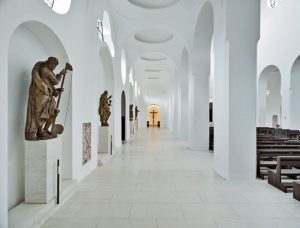In these days of diminishing urban congregations still trying to hold onto beautiful historic buildings, sometimes it is not hard to feel more like you are visiting a museum than a church when you stop inside. Sometimes that feeling can even happen during a worship service, there are so few people. As a church architect, I often get into a discussion with clients for whom we are designing a renovation of an historic building of living, breathing worship spaces versus the relatively static aspect of museums, where precious spaces and objects are preserved for their own sake. Some people see the museum-like quality of historic churches as appealing but I doubt that such a quality is generally helpful in achieving the vision or mission of the church.
When asked to renovate the Catholic church of St. Moritz in Augsburg, Germany, British architect John Pawson chose to further simplify a relatively plain historic building. Using an extremely limited palette of materials and colors, he has created spaces that he describes as allowing “us to focus on the things that matter”. He manipulates both daylight and electric light to change the perception of the main space at different times and for different purposes. The church’s website lists some of these varying purposes:
“Our church is to relax and to breathe a space that for almost 1000 years in the middle of Augsburg invites people to experience spirituality, a place of silence in the noise of the city, a place.
This space of the church can be experienced – at other times , with other sounds, in other words, other images.
services for certain groups are offered, for example, for lovers on Valentine’s Day.
There are prayers on current issues and events.” (translation from the German by Google Translator)
The full story, photos and plans can be found at St. Moritz Church | John Pawson Ltd. / Mindseye Lighting | Augsburg, Germany | Lighting | Architectural Record – including photos prior to the renovation. The photos of the renovated church very much remind me of several museums that I have visited. I think it is a beautiful space but I wonder how well it functions as a place of worship. When I reread the architect’s quote and looked at the images, I began to wonder what exactly are “the things that matter”?
As in all cases with architecture, I reserve any judgment of the building until I have visited it in person and used the space for at least one of the functions for which it was designed. It would certainly be worth a visit at several times of the day to see how the light is manipulated throughout the day. I will have to include it on my list of places to visit but if any of my readers have a chance to stop in and see it – or better yet, worship there – please let me know what you think!

